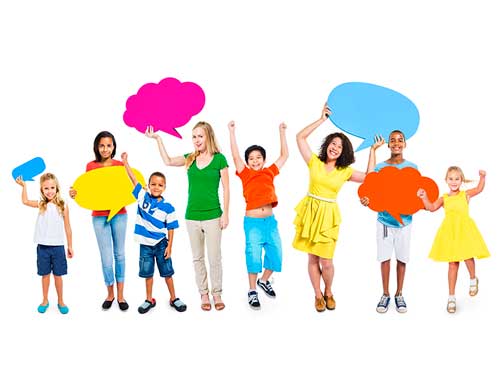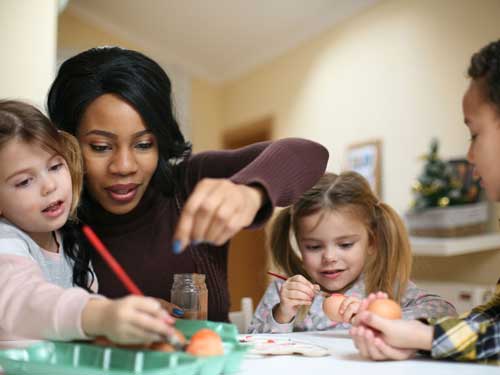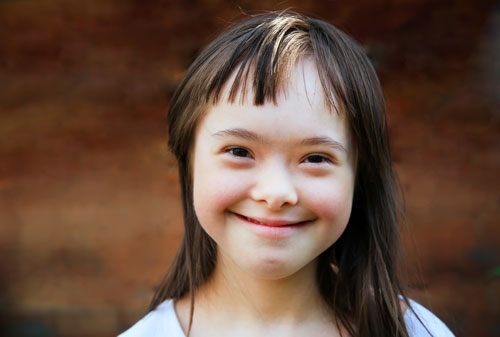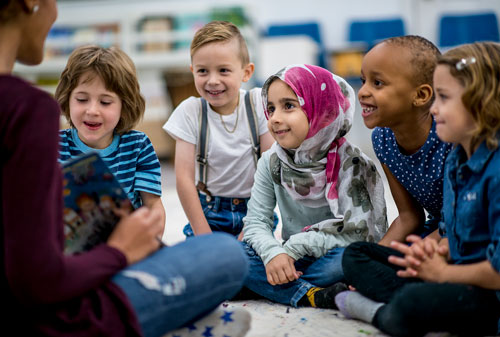




In 2013, a report entitled Early Language Delays in the UK was published by Newcastle University and the Save the Children charity. Its aim was to provide information on language delay in the United Kingdom and to explore the relationship between a child's family income and its ability to develop early language skills. The report sets out five principles that underpin speech, language and communication development.
Yn 2013, cyhoeddwyd adroddiad yn dwyn y teitl Early Language Delays in the UK gan Brifysgol Newcastle a’r elusen Save the Children. Ei nod oedd darparu gwybodaeth am oedi ieithyddol yn y Deyrnas Unedig ac i archwilio’r berthynas rhwng incwm teulu/gofalwyr plentyn a'i allu i ddatblygu sgiliau iaith cynnar. Mae’r adroddiad yn nodi pum egwyddor sy’n ategu datblygiad lleferydd, iaith a chyfathrebu.
Hint 1: Lorem ipsum dolor sit amet, consectetur adipisicing elit. Modi est praesentium earum exercitationem, accusantium molestiae asperiores reiciendis aliquam doloribus, delectus, cumque odio omnis rem, aliquid et. Quisquam eius, incidunt ab.
Awgrymiadau 1: Lorem ipsum dolor sit amet, consectetur adipisicing elit. Modi est praesentium earum exercitationem, accusantium molestiae asperiores reiciendis aliquam doloribus, delectus, cumque odio omnis rem, aliquid et. Quisquam eius, incidunt ab.

Language is the main method people use to communicate; therefore, a language needs to be learned in order to participate in society. Language has different forms; talking, listening, thinking, seeing, writing and reading:
Speech is a spoken language that is learned before the written language. Speech includes the ability to listen to the differences between sounds. It involves expressing the sounds that make up a language, and combining these sounds in order to pronounce sounds or make words. Speech includes phonology, namely sounds, patterns, sequences and combinations of speech sounds.
Communication is the way people send and receive messages. It includes speech and language as well as non-verbal communication e.g. facial expressions, gestures and body language. Communication takes place between at least two people and may include:
Literacy is the aspects of language that relate to oracy, reading and writing. Learning to read and write is a long process, which requires children to develop speaking and listening skills before learning about the connection between letters and spoken sounds. This leads to the development of literacy skills. One of the first steps in learning to read is to identify whole words by their shape. When learning to write, children learn how to form letters correctly.
Iaith yw’r prif ddull y mae pobl yn ei ddefnyddio i gyfathrebu; felly, mae angen dysgu iaith er mwyn cymryd rhan mewn cymdeithas. Mae gan iaith wahanol ffurfiau; siarad, gwrando, meddwl, gweld, ysgrifennu a darllen:
Lleferydd yw iaith leisiol sy’n cael ei dysgu cyn yr iaith ysgrifenedig. Mae lleferydd yn cynnwys y gallu i wrando ar y gwahaniaethau rhwng synau. Mae’n golygu mynegi’r synau sy'n rhan o iaith, a chyfuno'r synau hyn er mwyn ynganu seiniau neu wneud geiriau. Mae lleferydd yn cynnwys ffonoleg, sef seiniau, patrymau, dilyniannau a chyfuniadau seiniau lleferydd.
Cyfathrebu yw'r ffordd y mae pobl yn anfon a derbyn negeseuon. Mae’n cynnwys lleferydd ac iaith yn ogystal â chyfathrebu di-eiriau, e.e. mynegiant y wyneb, ystumiau ac iaith y corff. Mae cyfathrebu’n digwydd rhwng o leiaf ddau berson a gall gynnwys:
Llythrennedd yw’r agweddau o iaith sy’n ymwneud â llafaredd, darllen ac ysgrifennu. Mae dysgu darllen ac ysgrifennu’n broses hir, sy’n golygu bod angen i blant ddatblygu sgiliau siarad a gwrando cyn dysgu am y cysylltiad rhwng llythrennau a synau llafar. Mae hyn yn arwain at ddatblygu sgiliau llythrennedd. Un o’r camau cyntaf wrth ddysgu darllen yw adnabod geiriau cyfan yn ôl eu siâp. Wrth ddysgu ysgrifennu, mae plant yn dysgu sut i ffurfio llythrennau’n gywir.
Hint 2: Lorem ipsum dolor sit amet, consectetur adipisicing elit. Modi est praesentium earum exercitationem, accusantium molestiae asperiores reiciendis aliquam doloribus, delectus, cumque odio omnis rem, aliquid et. Quisquam eius, incidunt ab.
Awgrymiadau 2: Lorem ipsum dolor sit amet, consectetur adipisicing elit. Modi est praesentium earum exercitationem, accusantium molestiae asperiores reiciendis aliquam doloribus, delectus, cumque odio omnis rem, aliquid et. Quisquam eius, incidunt ab.

Children develop language at a very rapid rate between the ages of 0 and 5 years. The pre-linguistic stage is the period before children say their first words, approximately 0-12 months. During this time, babies can communicate their needs through crying and facial expressions. Babies usually respond to adults by matching the pitch of the person they are talking to. Often they will respond non-verbally e.g. by smiling. Before babies learn spoken language, they respond to speech and sound. The ability to understand a language usually occurs before the ability to speak it.
Children begin to communicate orally through babble and then using one or two words. This then turns into putting two words together, followed by three, and then whole sentences. Once a child is 2, they usually speak more than 200 words, and learn new words very quickly. The rate of vocabulary is influenced by the amount of language the child is hearing. By the age of 6, children usually use over 10,000 words. An 8-year-old can hold conversations like an adult.
Pre-linguistic steps - birth up to 12 months:
There are two aspects to language development:
Between the ages of 1-2, infants respond to familiar instructions e.g. ‘come here' (receptive language). They will babble and can recognise the names of familiar objects (expressive language).
By the age of 3, children can follow two-step instructions, such as “put the cup in the sink and the banana peel in the bin” (receptive language). They will use sentences of 3-4 words (language production).
By the age of 5, children understand the relationship between objects e.g. 'the girl who reads a book' and 'the boy who plays with the blocks' (receptive language). They can converse with another person (expressive language).
Between about 7-8 years, children are able to listen for longer periods e.g. the class teacher reading a long story (receptive language). They can express their views (expressive language).
Early literacy (mark making) - children like to copy adults and take advantage of writing utensils by making marks on paper or any available area. When developing early literacy skills, children form lines and dots before developing the ability to copy a mark made by others. Gradually, they begin to form curves and circles. They then develop the ability to copy straight lines and curves made by others. Finally, they develop the ability to use straight lines and curves to form symbols.
Typical patterns/stages of speech, language and communication:
Newborn – Shows an interest in new sounds.
1 month - Makes crying, cooing and babbling noises.
3 months - Responds to different adult voice tones by smiling and laughing. Shouts out loud to express need.
6 months - Responds to speech and listen to sounds. Understands the meaning of 'ta-ta' and perhaps responds by waving hands.
9 months - Communicates using sounds. Turns towards familiar voices across a room and begins to respond to own name.
12 months - Knows own name. Says between 2 and 6 words.
18 months - Uses 6-20 familiar words and understands much more. Repeats the last word of short sentences. Can recognise names of familiar objects.
2 years old - Refers to themselves by name. Knows the names of parts of the body (hair, nose, feet).
2 ½ years old - Knows their full name. Uses more than 200 words.
3 - 5 years - Often asks 'Why?' Knows their full name and address. Accurately reports recent events. They will be able to converse with another person. Shows interest in reading and writing.
5 - 10 years - Express themselves through speaking and writing. Learns that the same word can mean two things e.g. 'orange' the fruit and 'orange' the colour. Listening for longer periods.
11-19 years - Can write long essays. Uses long sentences. Follows complex instructions.
Mae plant yn datblygu iaith ar gyfradd gyflym iawn rhwng 0 a 5 oed. Y cam cyn-ieithyddol yw'r cyfnod cyn i blant ddweud eu geiriau cyntaf, tua 0-12 mis. Yn ystod y cyfnod hwn, gall babanod gyfleu beth yw eu hanghenion trwy grïo a mynegiant yr wyneb. Mae babanod, fel arfer, yn ymateb i oedolion trwy gyfateb traw'r person sy'n siarad â nhw. Yn aml byddant yn ymateb yn ddi-eiriau, e.e. trwy wenu. Cyn i fabanod ddysgu iaith lafar, maent yn ymateb i sain a lleferydd. Mae'r gallu i ddeall iaith fel arfer yn digwydd cyn y gallu i’w siarad.
Mae plant yn dechrau cyfathrebu ar lafar trwy faldorddi (babble) ac yna trwy ddefnyddio un neu ddau o eiriau. Mae hyn wedyn yn troi i mewn i roi dau air gyda'i gilydd, ac yna dri, ac yna frawddegau cyfan. Unwaith y bydd plentyn yn 2 oed, mae, fel arfer, yn siarad mwy na 200 o eiriau, ac yn dysgu geiriau newydd yn gyflym iawn. Mae cyfradd yr eirfa yn cael ei ddylanwadu gan faint o iaith y mae’r plentyn yn ei chlywed. Erbyn cyrraedd 6 oed, mae plant, fel arfer, yn defnyddio dros 10,000 o eiriau. Mae plentyn 8 oed yn gallu cynnal sgyrsiau fel oedolyn.
Camau cyn-ieithyddol - genedigaeth hyd at 12 mis:
Mae dwy agwedd o ddatblygiad iaith:
Rhwng 1-2 oed, mae babanod yn ymateb i gyfarwyddiadau cyfarwydd, e.e. ‘tyrd/dere yma’ (derbyn iaith). Byddant yn baldorddi ac yn gallu adnabod enwau gwrthrychau cyfarwydd (cynhyrchu iaith).
Erbyn 3 oed, mae plant yn gallu dilyn cyfarwyddiadau dau gam, fel “rho’r cwpan yn y sinc a’r croen banana yn y bin” (derbyn iaith). Byddant yn defnyddio brawddegau o 3 - 4 gair (cynhyrchu iaith).
Erbyn 5 oed, mae plant yn deall y berthynas rhwng gwrthrychau e.e. ‘y ferch sy’n darllen llyfr’ a ‘y bachgen sy’n chwarae gyda’r blociau’ (derbyn iaith ). Maen nhw’n gallu sgwrsio â pherson arall (cynhyrchu iaith).
Rhwng tua 7-8 oed, mae plant yn gallu gwrando am gyfnodau hirach, e.e. yr athrawes ddosbarth yn darllen stori hir (derbyn iaith). Maen nhw’n gallu mynegi eu barn (cynhyrchu iaith).
Llythrennedd cynnar (gwneud marciau) - Mae plant yn hoffi copïo oedolion a manteisio ar offer ysgrifennu drwy wneud marciau ar bapur neu unrhyw arwynebedd sydd ar gael. Wrth ddatblygu sgiliau llythrennedd cynnar, mae plant yn ffurfio llinellau a dotiau cyn datblygu'r gallu i gopïo marc a wneir gan eraill. Yn raddol, maent yn dechrau ffurfio cromliniau (curves) a chylchoedd. Yna, maen nhw’n datblygu'r gallu i gopïo llinellau syth a chromliniau a wneir gan eraill. Yn olaf, maent yn datblygu'r gallu i ddefnyddio llinellau syth a chromliniau i ffurfio symbolau.
Patrymau/cyfnodau nodweddiadol lleferydd, iaith a chyfathrebu:
Newydd-anedig - Dangos diddordeb mewn synau newydd.
1 mis – Gwneud synau crïo, cŵan a baldorddi.
3 mis - Ymateb i wahanol donau llais oedolion gan wenu a chwerthin. Gweiddi’n uchel i fynegi angen.
6 mis - Ymateb i leferydd a gwrando ar synau. Deall ystyr ‘ta-ta’ ac efallai ymateb drwy chwifio dwylo.
9 mis - Cyfathrebu drwy ddefnyddio synau. Troi at leisiau cyfarwydd ar draws ystafell a dechrau ymateb i'w enw ei hun.
12 mis - Gwybod enw ei hun. Dweud rhwng 2 a 6 gair.
18 mis - Defnyddio 6-20 geiriau cyfarwydd ac yn deall llawer mwy. Yn ailadrodd gair olaf o frawddegau byr. Yn gallu adnabod enwau gwrthrychau cyfarwydd.
2 oed - Yn cyfeirio at eu hunain yn ôl enw. Yn gwybod enwau rhannau o'r corff (gwallt, trwyn, traed).
2 ½ oed - Yn gwybod eu henw llawn. Defnyddio mwy na 200 o eiriau.
3 - 5 oed - Yn aml yn gofyn ‘Pam?’ Yn gwybod eu henw llawn a’u cyfeiriad. Yn adrodd digwyddiadau diweddar yn gywir. Byddant yn gallu sgwrsio â pherson arall. Dangos diddordeb mewn darllen ac ysgrifennu.
5 - 10 oed - Mynegi eu hunain drwy siarad ac ysgrifennu. Dysgu y gall yr un gair olygu dau beth, e.e. 'oren' y ffrwyth ac 'oren' y lliw. Gwrando am gyfnodau hirach.
11 -19 oed - Yn gallu ysgrifennu traethodau hir. Yn defnyddio brawddegau hir. Dilyn cyfarwyddiadau cymhleth.
Hint 3: Lorem ipsum dolor sit amet, consectetur adipisicing elit. Modi est praesentium earum exercitationem, accusantium molestiae asperiores reiciendis aliquam doloribus, delectus, cumque odio omnis rem, aliquid et. Quisquam eius, incidunt ab.
Awgrymiadau 3: Lorem ipsum dolor sit amet, consectetur adipisicing elit. Modi est praesentium earum exercitationem, accusantium molestiae asperiores reiciendis aliquam doloribus, delectus, cumque odio omnis rem, aliquid et. Quisquam eius, incidunt ab.

Support at home: The language of the home is important as a child learns Welsh. If the parents/carers can speak Welsh, they can offer support to the child by practicing the language, reading books together, listening to music, playing games, and so on.
Previous information: If the child has heard Welsh regularly before attending the setting, they can build on this. This is an advantage when learning the language. It is important that the setting is aware of each child's linguistic circumstances before they start at the setting. This gives ideas for planning, and an opportunity to set the baseline for each child's development at the start of their journey of learning Welsh.
Simultaneous bilingualism means that children experience two languages from birth. Both languages are used at the same time, for example, some children are brought up in a bilingual home and learn two languages simultaneously, side by side.
Sequential bilingualism is when children come into contact with a new language, for example, a child whose first language is English is attending a Cylch Meithrin that uses Welsh as the main language.
The advantages of bilingualism/multilingualism for non-Welsh speaking children are being able to read, write, speak, understand and use Welsh as well as children from Welsh speaking homes. Bilingual/multilingual children tend to achieve highly within the curriculum and perform better in examinations. Learning a second language from an early age helps children to hear different languages and helps to learn a third or fourth language as they grow older. There are many other benefits to being bilingual or multilingual, for example:
The bilingual brain is used to handling two languages at the same time. This develops enhanced cognitive skills, for example, attention management, organising information, ignoring redundant information, flexible thinking, concentration and remembering. Bilingual children learn better in noisy environments e.g. the classroom, and cope better with changes in their environment. This is because the bilingual brain focuses on making sense of words and this helps them focus on their work.
The bilingual brain has two complex language networks to store, process and retrieve information. Both languages are active in the brain at all times. An individual manages both language networks in order to choose one language to speak, rather than a mix of both. The bilingual brain can change back and forth from one language to another suddenly and often. This is known as 'code switching', which is transferring a code from one language to another. The language networks of a bilingual person are always active and compete against each other every second they try to speak or listen. This means that bilingual people pass code from one language to the other when speaking and listening, and this changes certain parts of the brain.
Mae amgylchiadau unigol plentyn yn effeithio ar y ffordd y mae’n caffael iaith:
Cefnogaeth yn y cartref: Mae iaith y cartref yn bwysig wrth i blentyn ddysgu’r Gymraeg. Os yw’r rhieni/gofalwyr yn gallu siarad Cymraeg, maent yn gallu cynnig cefnogaeth i’r plentyn drwy ymarfer yr iaith, darllen llyfrau gyda’i gilydd, gwrando ar gerddoriaeth, chwarae gemau, ac yn y blaen.
Gwybodaeth flaenorol: Os yw’r plentyn wedi clywed y Gymraeg yn gyson cyn mynychu’r lleoliad, mae’n gallu adeiladu ar hyn. Mae hyn yn fantais wrth iddo ddysgu’r iaith. Mae’n bwysig bod y lleoliad yn ymwybodol o amgylchiadau ieithyddol pob plentyn cyn iddynt gychwyn yn y lleoliad. Mae hyn yn rhoi syniadau ar gyfer cynllunio, a chyfle i osod y llinell sylfaen ar gyfer datblygiad pob plentyn ar gychwyn eu taith o ddysgu’r Gymraeg.
Mae dwyieithrwydd cydamserol yn golygu bod plant yn cael profiad o ddwy iaith o'u genedigaeth. Mae'r ddwy iaith yn cael eu defnyddio ar yr un pryd, er enghraifft, mae rhai plant yn cael eu magu ar aelwyd ddwyieithog ac yn dysgu dwy iaith yn gyfamserol, ochr yn ochr â’i gilydd.
Dwyieithrwydd olynol yw pan fydd plant yn dod i gysylltiad ag iaith newydd, er enghraifft, plentyn sy'n siarad Saesneg fel iaith gyntaf yn dechrau mynychu Cylch Meithrin sy’n defnyddio’r Gymraeg fel y brif iaith.
Manteision dwyieithrwydd/amlieithrwydd i blant di-gymraeg yw gallu darllen, ysgrifennu, siarad, deall a defnyddio'r Gymraeg cystal â phlant o gartrefi Cymraeg eu hiaith. Mae plant dwyieithog/amlieithog yn tueddu i gyflawni’n uchel o fewn y cwricwlwm ac i berfformio’n well mewn arholiadau. Mae dysgu ail iaith o oed cynnar yn helpu plant i allu clywed ieithoedd gwahanol ac yn gymorth wrth ddysgu trydedd neu bedwaredd iaith wrth iddynt dyfu’n hŷn.
Mae sawl mantais arall i fod yn ddwyieithog neu’n amlieithog, er enghraifft:
Mae’r ymennydd dwyieithog wedi arfer â thrin dwy iaith ar yr un pryd. Mae hyn yn datblygu sgiliau uwch wybyddol (cognitive) gwell, er enghraifft, rheoli sylw, trefnu gwybodaeth, diystyru gwybodaeth ddiangen, meddwl yn hyblyg, canolbwyntio a chofio.
Mae plant dwyieithog yn dysgu'n well mewn amgylcheddau swnllyd, e.e. yr ystafell ddosbarth, ac yn ymdopi’n well i newidiadau yn eu hamgylchedd. Mae hyn oherwydd bod yr ymennydd dwyieithog yn canolbwyntio ar wneud synnwyr o eiriau ac mae hyn yn eu helpu i ganolbwyntio ar eu gwaith.
Mae gan yr ymennydd dwyieithog ddau rwydwaith iaith gymhleth i gadw, prosesu ac adalw gwybodaeth. Mae’r ddwy iaith yn weithgar yn yr ymennydd drwy’r amser. Mae unigolyn yn rheoli’r ddau rwydwaith ieithyddol er mwyn dewis un iaith i siarad, yn hytrach na chymysgedd o’r ddwy. Gall yr ymennydd dwyieithog newid yn ôl ac ymlaen o un iaith i’r llall yn sydyn ac yn aml. Gelwir hyn yn ‘code switching’, sef trosglwyddo cod o un iaith i’r llall. Mae rhwydweithiau iaith unigolyn dwyieithog bob amser yn weithredol ac yn cystadlu yn erbyn ei gilydd bob eiliad y maent yn ceisio siarad neu wrando. Mae hyn yn golygu bod pobl ddwyieithog yn trosglwyddo cod o un iaith i’r llall wrth siarad a gwrando, ac mae hyn yn newid rhannau penodol o’r ymennydd.
Hint 4: Lorem ipsum dolor sit amet, consectetur adipisicing elit. Modi est praesentium earum exercitationem, accusantium molestiae asperiores reiciendis aliquam doloribus, delectus, cumque odio omnis rem, aliquid et. Quisquam eius, incidunt ab.
Awgrymiadau 4: Lorem ipsum dolor sit amet, consectetur adipisicing elit. Modi est praesentium earum exercitationem, accusantium molestiae asperiores reiciendis aliquam doloribus, delectus, cumque odio omnis rem, aliquid et. Quisquam eius, incidunt ab.

Considering how speech, language and communication affect all areas of development, barriers can arise for children for whom Welsh is a second language. They include:
Gan ystyried sut mae lleferydd, iaith a chyfathrebu’n effeithio ar bob maes o ddatblygiad, gall rhwystrau codi i blant sydd â’r Gymraeg yn ail iaith iddyn nhw. Maen nhw’n cynnwys:
Hint 5: Lorem ipsum dolor sit amet, consectetur adipisicing elit. Modi est praesentium earum exercitationem, accusantium molestiae asperiores reiciendis aliquam doloribus, delectus, cumque odio omnis rem, aliquid et. Quisquam eius, incidunt ab.
Awgrymiadau 5: Lorem ipsum dolor sit amet, consectetur adipisicing elit. Modi est praesentium earum exercitationem, accusantium molestiae asperiores reiciendis aliquam doloribus, delectus, cumque odio omnis rem, aliquid et. Quisquam eius, incidunt ab.

We have already looked at patterns/stages of speech, language and communication development. When a child is learning to talk, they usually follow certain patterns and develop skills at particular ages. Every child develops at their own pace and with different levels of speech, language and communication. The language of the home and their experiences affect children's level of speech, language and communication development, as well as any specific needs.
Sometimes, children have difficulty developing speech, language and communication skills. This may be due to slow language development. The delay in speech, language and communication development is not usually caused by any underlying factor, and many children will resolve the difficulties by the time they reach about 3-4 years of age.
Childcare workers need to be aware of the different linguistic experiences that young children bring to the early years setting, as well as the physiological, psychological and sociological factors that can affect language development.
Children need to be sufficiently stimulated and given opportunities to interact with others in order to develop their speech, language and communication. This means that an adult needs to talk and play with the child so that they can hear language constantly. If the language is pronounced correctly, it has a positive effect on the child's speech, language and communication development. If the child is not stimulated, they will not be given opportunities to hear language. A young child in a large family may not get much attention from adults, or they may have a big brother or sister who speaks for them. Some parents may not understand the importance of using language consistently with their baby, and this can lead to delays in early language skills. Parents living in poverty may not have the time or resources needed to read with their children, and this can affect their literacy skills.
A high-quality home learning environment has a positive impact on children's speech, language and communication development. If children have had experiences and opportunities to practise their speech, language and communication skills in a way that suits their individual needs, this will have a positive impact on their development. A learning environment that offers children opportunities to hear and see language has a positive effect on their speech, language and communication development. Regularly hearing stories and songs and having opportunities to look at books develops children’s speech, language and communication skills.
Learning difficulties, e.g. autism, can make it difficult for a child to process words. Children with autism often have concentration problems and find it difficult to process what is being said. Autism affects communication skills e.g. understanding spoken and non-verbal language, recognising and understanding the feelings of others and control one's own feelings. Autism and Asperger's syndrome are part of the same condition. People with Asperger's syndrome have fewer speech problems, but they can have difficulties with understanding and processing language.
The language skills of children with Down's syndrome tend to develop more slowly than other children. Children with Down's syndrome usually babble like other children, but do not develop to try to say words. They tend to use more gestures for a longer period. One reason for this is that children with Down's syndrome find it difficult to produce and say words. Attention deficit and hyperactivity disorder (ADHD) includes symptoms such as hyperactivity; or challenging, disruptive and inappropriate behaviour; which can affect language and communication development.
If a child has a hearing or visual impairment, their speech, language and communication are impaired as they do not hear sounds around them or even their own voice. A child needs to hear language to be able to use it. It is necessary to see facial expressions and body language to be able to communicate. Therefore, if a child has a sensory impairment, speech, language and communication development will be affected. Cleft lip or palate, a gap or fissure that can affect the lip or palate (the roof of the mouth), can lead to speech and language delays as children are unable to pronounce words until the gaps have been repaired.
Other individual needs may affect speech, language and communication development e.g. dyspraxia. Children with dyspraxia have difficulties with movement, language and developing ideas. The handwriting is messy and although the child often has good ideas, they are not able to record them on paper. Dyslexia affects the ability to read, spell and write. Children who suffer from anxiety or who are particularly shy may have difficulty developing speech, language and communication skills, as they are not used to interacting with others. Disorders with motor skills will affect a young child's ability to make marks. If a young child is unable to make marks, it affects their ability to form letters and write.
Rydym eisoes wedi edrych ar batrymau/cyfnodau datblygiad lleferydd, iaith a chyfathrebu. Pan mae plentyn yn dysgu siarad mae fel arfer yn dilyn patrymau penodol ac yn datblygu sgiliau ar oedrannau penodol. Mae pob plentyn yn datblygu ar ei gyflymder ei hun a chyda lefelau gwahanol o leferydd, iaith a chyfathrebu. Mae iaith y cartref a’u profiadau’n effeithio ar lefel datblygiad iaith, lleferydd a chyfathrebu plant, yn ogystal ag unrhyw anghenion penodol.
Weithiau, mae plant yn cael trafferth datblygu sgiliau lleferydd, iaith a chyfathrebu. Gall hyn fod oherwydd datblygiad ieithyddol araf. Nid yw’r oedi mewn datblygiad lleferydd, iaith a chyfathrebu fel arfer yn cael ei achosi gan unrhyw ffactor sylfaenol a bydd llawer o blant yn datrys yr anawsterau erbyn iddynt gyrraedd tua 3-4 oed.
Mae’n rhaid i gweithwyr gofal plant fod yn ymwybodol o’r gwahanol brofiadau ieithyddol y mae plant ifanc yn dod gyda nhw i’r lleoliad blynyddoedd cynnar ynghyd â’r ffactorau ffisiolegol, seicolegol a chymdeithasegol sy’n gallu effeithio ar ddatblygiad iaith.
Mae angen i blant gael digon o symbyliad a chyfleoedd i ryngweithio â phobl eraill er mwyn datblygu eu lleferydd, iaith a chyfathrebu. Mae hyn yn golygu bod angen i oedolyn siarad a chwarae â’r plentyn er mwyn iddo glywed iaith yn gyson. Os yw’r iaith yn cael ei hynganu’n gywir, mae’n cael effaith bositif ar ddatblygiad lleferydd, iaith a chyfathrebu’r plentyn. Os na fydd y plentyn yn cael ei symbylu, ni fydd yn derbyn cyfleoedd i glywed iaith. Efallai na fydd plentyn ifanc mewn teulu mawr yn cael llawer o sylw gan oedolion, neu efallai bod ganddynt frawd neu chwaer fawr sy’n siarad drostynt. Efallai na fydd rhai rhieni/gofalwyr yn deall pwysigrwydd defnyddio iaith yn gyson gyda'u baban, a gall hyn arwain at oedi mewn sgiliau iaith cynnar. Efallai na fydd gan rieni/gofalwyr sy'n byw mewn tlodi yr amser na'r adnoddau sydd eu hangen i ddarllen gyda’u plant, ac mae hyn yn gallu effeithio ar eu sgiliau llythrennedd.
Mae amgylchedd dysgu o safon yn y cartref yn cael effaith cadarnhaol ar ddatblygiad lleferydd, iaith a chyfathrebu plant. Os ydy plant wedi derbyn profiadau a chyfleoedd i ymarfer eu sgiliau lleferydd, iaith a chyfathrebu mewn ffordd sy’n addas ar gyfer eu hanghenion unigol, bydd hyn yn cael effaith bositif ar eu datblygiad. Mae amgylchedd dysgu sy’n cynnig cyfleoedd i blant glywed a gweld iaith yn cael effaith bositif ar eu datblygiad lleferydd, iaith a chyfathrebu. Mae clywed straeon a chaneuon yn rheolaidd a chyfleoedd i edrych ar lyfrau yn datblygu sgiliau lleferydd, iaith a chyfathrebu plant.
Gall anawsterau dysgu, e.e. awtistiaeth, ei gwneud yn anodd i blentyn brosesu geiriau. Yn aml, bydd gan blant ag awtistiaeth broblemau canolbwyntio a byddant yn ei chael yn anodd prosesu’r hyn sy’n cael ei ddweud. Mae awtistiaeth yn effeithio ar sgiliau cyfathrebu, e.e. deall iaith lafar a di-eiriau, adnabod a deall teimladau pobl eraill a rheoli teimladau eu hunain. Mae awtistiaeth a syndrom Asperger yn rhan o’r un cyflwr. Mae gan bobl â syndrom Asperger lai o broblemau gyda lleferydd, ond gallant gael anawsterau wrth ddeall a phrosesu iaith.
Mae sgiliau iaith plant â syndrom Down yn tueddu i ddatblygu'n arafach na phlant eraill. Mae plant â syndrom Down fel arfer yn baldorddi fel plant eraill, ond nid ydynt yn datblygu i geisio dweud geiriau. Maent yn tueddu i ddefnyddio mwy o ystumiau am gyfnod hirach. Un rheswm am hyn ydy bod plant â syndrom Down yn ei chael hi'n anodd cynhyrchu a dweud geiriau. Mae anhwylder diffyg canolbwyntio a gorfywiogrwydd (ADHD) yn cynnwys symptomau fel gorfywiogrwydd; neu ymddygiad heriol, aflonyddgar ac amhriodol; sy’n gallu effeithio ar ddatblygiad iaith a chyfathrebu.
Os yw plentyn â nam ar y clyw neu olwg, bydd hynny’n amharu ar ei leferydd, iaith a chyfathrebu gan nad yw’n clywed synau o’i gwmpas neu hyd yn oed ei lais ei hun. Mae angen i blentyn glywed iaith er mwyn gallu ei defnyddio. Mae angen gweld mynegiant yr wyneb ac iaith y corff i allu cyfathrebu. Felly, os oes gan blentyn nam synhwyrol, bydd datblygiad lleferydd, iaith a chyfathrebu yn cael ei effeithio. Gall gwefus neu daflod hollt (cleft), sef bwlch neu agen sy’n gallu effeithio ar y wefus neu’r daflod (nenfwd y geg), arwain at oedi lleferydd ac iaith gan nad yw plant yn gallu ynganu geiriau nes bod y bylchau wedi cael eu trwsio.
Gall anghenion unigol eraill effeithio ar ddatblygiad lleferydd, iaith a chyfathrebu, e.e. dyspracsia. Mae plant â dyspracsia yn cael anawsterau gyda symudiadau, iaith a datblygu syniadau. Mae’r llawysgrifen yn anniben ac er bod y plentyn yn aml â syniadau da, ni fydd yn medru eu cofnodi ar bapur. Mae dyslecsia’n effeithio ar y gallu i ddarllen, sillafu ac ysgrifennu. Efallai y bydd plant sy'n dioddef o orbryder neu sy'n arbennig o swil yn cael trafferth wrth ddatblygu sgiliau lleferydd, iaith a chyfathrebu, gan nad ydynt wedi arfer rhyngweithio ag eraill. Bydd anhwylderau gyda sgiliau echddygol yn effeithio ar allu plentyn ifanc i wneud marciau. Os nad yw plentyn ifanc yn gallu gwneud marciau, mae’n effeithio ar ei allu i ffurfio llythrennau ac ysgrifennu.
Hint 6: Lorem ipsum dolor sit amet, consectetur adipisicing elit. Modi est praesentium earum exercitationem, accusantium molestiae asperiores reiciendis aliquam doloribus, delectus, cumque odio omnis rem, aliquid et. Quisquam eius, incidunt ab.
Awgrymiadau 6: Lorem ipsum dolor sit amet, consectetur adipisicing elit. Modi est praesentium earum exercitationem, accusantium molestiae asperiores reiciendis aliquam doloribus, delectus, cumque odio omnis rem, aliquid et. Quisquam eius, incidunt ab.

Each setting has a policy in relation to developing children's speech, language and communication skills. The language policy will include the setting's goals in terms of promoting speech, language and communication skills, e.g. offering early years experiences through the medium of Welsh. The policy will outline how children will be supported to develop their speech, language and communication skills. Welsh-medium settings that use the immersion method as a means of introducing a second language may refer to research that supports the method, e.g. Professor Colin Baker's research in his book ‘A Parents’ and Teachers’ Guide to Bilingualism’ (2007).
Policies can refer to current strategies, e.g. Cymraeg 2050: A million Welsh speakers, the Welsh Government's strategy for promoting and facilitating the use of Welsh. Reference to current research and documentation helps staff, parents/carers, visitors and other stakeholders understand the rationale behind the policy.
A positive environment is one that encourages the development of all children. The physical environment will affect how children communicate. The space available inside and outside the setting affects the way resources are set up. This affects the range of opportunities that children have to communicate when using the resources.
Having a suitable environment requires consideration of space and equipment, hygiene and safety, as well as staffing levels, and the ability and knowledge that staff have to support each child's speech, language and communication skills. Childcare workers need to secure a wide range of activities and arrange opportunities and equipment for play and learning that will help a child to develop. Therefore, there is a need to create an environment that is designed for play and that allows the child to communicate with staff and other children. Resources and activities that are relevant to children's interests and experiences, and build on what they already know, need to be provided. By observing children, it is possible to learn about their strengths and weaknesses, likes and dislikes. This helps settings provide activities and resources that will meet their individual needs.
In order to support a positive environment full of communication, there is a need to plan for continuous provision, which is what is provided for children in terms of permanent learning opportunities. When playing in the areas of continuous provision, children will practice their communication skills. This can happen with other children, staff or even on their own. Examples of areas of continuous provision are:
A positive environment supports language development by providing suitable areas for communicating with other adults or children. Cosy little areas can help reduce background noise and encourage shy children to communicate as they feel safe. Resources such as puppets, recording equipment and toys (such as phones) allow children to communicate and develop their speech and language skills. Children should have opportunities to write in the indoor and outdoor area e.g. forming letters by using a tub of shaving foam.
Books provide opportunities for children to develop language. Therefore, children should be encouraged to look at or read books, depending on their age and stage of development. Children enjoy listening to stories over and over again. The repetition is useful in developing vocabulary and understanding of the stories. Puppets can be used to tell stories. Children enjoy making their own puppets from items such as lollipop sticks. Role play is a great way to extend language skills and encourage children to communicate. Children can explore role play areas and learn how to play with other children. As children role play, they use new language, e.g. when answering a phone at the surgery. Childcare workers need to model language in the role play area first by playing with the children. Mud kitchens are another way of offering role play situations that allow the child to have control over their play.
Arts and crafts activities support the development of speech, language and communication as children talk about what they are doing. Large-scale painting allows for more interaction with other children as they discuss their ideas, e.g. provide large rolls of wallpaper for painting with friends.
Displays support a positive environment by sharing information with parents/carers about the themes. This enables them to participate in their children's education and strengthens the links with the home. The setting can encourage parents/carers to discuss the themes with children in order to extend the learning. Displays are a good way to showcase the children's work e.g. arts and crafts work. This encourages children to look, think, consider, explore, research and talk about their interests.
In order to support children to develop speech, language and communication skills, it is essential that childcare workers interact effectively with children at all times. The quality of communication is critical to ensuring that children develop speech, language and communication skills. This means that an adult needs to talk and play with the child so that they can hear language constantly. If language is pronounced correctly, it has a positive effect on the child's speech, language and communication development.
For childcare workers with a low level of Welsh, using a little Welsh can show that they understand the needs of children and their families/carers and make them feel comfortable. It is important that childcare workers are able to demonstrate basic linguistic courtesy towards children and their families. An example of this is pronouncing names correctly and using simple greetings such as ‘bore da’ and ‘croeso'. Other staff can support these childcare workers by modelling the use of language patterns when interacting with children and their families/carers.
If the setting has adopted ways of working which consider a child-centred approach, the child is always at the centre of the learning process which helps with meeting their individual needs. This means looking at issues from the child's perspective and understanding the different language experiences that young children bring to the early years setting. Focusing on the child can take into account his individual needs and interests, as well as the experiences they have already had and listening to their ideas. The children are involved in the planning. The role of the childcare worker is to give the children choices. The environment and specific activities must be planned to include all children and ensure that everyone is fully involved in the activities. This means that activities need to be adapted to meet specific needs, e.g. language needs or disability. This could mean staff learning Makaton to support children with speech, language and communication difficulties.
Providing a positive environment depends on the commitment of staff with regards to meeting children's needs and rights to ensure that they all benefit from the provision. Children are individuals and each person's needs are different and so must be flexible and sensitive in responding to them. It is important that settings demonstrate that they recognise the value of everyone by valuing the cultural background of individual children and considering their customs, values and beliefs. The learning environment, resources or activities need to be adapted to ensure that all children have opportunities to communicate. For example, changing the quiet/reading area to ensure it is accessible to a child who uses a wheelchair. Equipment, pictures, books and activities should reflect all children in a positive way. For example, books that show strong, capable characters from a variety of cultures, or children with disabilities.
Mae gan bob lleoliad bolisi mewn perthynas â datblygu sgiliau lleferydd, iaith a chyfathrebu plant. Bydd y polisi iaith yn cynnwys nodau’r lleoliad o ran hybu sgiliau lleferydd, iaith a chyfathrebu, e.e. cynnig profiadau blynyddoedd cynnar trwy gyfrwng y Gymraeg. Bydd y polisi’n amlinellu sut y caiff plant eu cefnogi i ddatblygu’u sgiliau lleferydd, iaith a chyfathrebu. Gall lleoliadau cyfrwng Cymraeg sy’n defnyddio’r dull trochi fel ffordd o gyflwyno ail iaith gyfeirio at ymchwil sy’n cefnogi’r dull, e.e. ymchwil yr Athro Colin Baker yn ei lyfr ‘A Parents’ and Teachers’ Guide to Bilingualism’ (2007).
Gall polisïau gyfeirio at strategaethau cyfredol, e.e. Cymraeg 2050: Miliwn o siaradwyr Cymraeg erbyn 2050, sef strategaeth Llywodraeth Cymru ar gyfer hybu a hwyluso defnyddio’r Gymraeg. Mae cyfeirio at ymchwil a dogfennaeth gyfredol yn helpu staff, rhieni/gofalwyr, ymwelwyr a rhanddeiliaid eraill i ddeall y rhesymeg sy’n sail i’r polisi.
Mae amgylchedd positif yn un sy'n annog datblygiad pob plentyn. Bydd yr amgylchedd ffisegol yn effeithio ar y ffordd y mae plant yn cyfathrebu. Mae’r gofod sydd ar gael y tu fewn a thu allan y lleoliad yn effeithio ar y ffordd y mae adnoddau’n cael eu gosod. Mae hyn yn effeithio ar ystod y cyfleoedd sydd gan blant i gyfathrebu wrth ddefnyddio’r adnoddau.
wynEr mwyn cefnogi amgylchedd cadarnhaol sy’n llawn cyfathrebu, mae angen cynllunio ar gyfer darpariaeth barhaus, sef yr hyn sy’n cael ei ddarparu i blant o ran cyfleoedd dysgu drwy’r amser. Wrth chwarae yn yr ardaloedd sy’n rhan o’r ddarpariaeth barhaus, bydd plant yn ymarfer eu sgiliau cyfathrebu. Mae hyn yn gallu digwydd gyda phlant eraill, staff neu hyd yn oed ar eu pennau’u hunain. Enghreifftiau o ardaloedd sy’n rhan o ddarpariaeth barhaus yw:
Mae amgylchedd cadarnhaol yn cefnogi datblygiad ieithyddol drwy ddarparu ardaloedd addas ar gyfer cyfathrebu gydag oedolion neu blant eraill. Gall ardaloedd bach clyd helpu i leihau sŵn yn y cefndir ac annog plant swil i gyfathrebu gan eu bod yn teimlo’n ddiogel. Gall adnoddau fel pypedau, offer recordio a theganau (megis ffonau) alluogi plant i gyfathrebu a datblygu eu sgiliau iaith a lleferydd. Dylai plant gael cyfleoedd i ysgrifennu yn yr ardal dan do ac yn yr awyr agored, e.e. ffurfio llythrennau mewn twb o sebon siafio.
Mae llyfrau’n darparu cyfleoedd i blant ddatblygu iaith. Felly, dylid annog plant i edrych ar neu ddarllen llyfrau, yn dibynnu ar eu hoed a'u cyfnod o ddatblygiad. Mae plant yn mwynhau gwrando ar straeon dro ar ôl tro. Mae'r ailadrodd yn ddefnyddiol wrth ddatblygu geirfa a dealltwriaeth o’r straeon. Gellir defnyddio pypedau er mwyn adrodd straeon. Mae plant yn mwynhau gwneud pypedau eu hunain o eitemau fel ffyn lolipop. Mae chwarae rôl yn ffordd wych o ymestyn sgiliau iaith ac annog plant i gyfathrebu. Gall plant archwilio ardaloedd chwarae rôl a dysgu sut i chwarae â phlant eraill. Wrth i blant chwarae rôl, maen nhw’n defnyddio iaith newydd, e.e. wrth ateb ffôn yn y feddygfa. Mae angen i gweithwyr gofal plant fodelu iaith yn yr ardal chwarae rôl yn gyntaf drwy chwarae gyda’r plant. Mae ceginau mwd yn ffordd arall o gynnig sefyllfaoedd chwarae rôl sy'n galluogi'r plentyn i gael rheolaeth dros ei chwarae.
Mae gweithgareddau celf a chrefft yn cefnogi datblygiad iaith, lleferydd a chyfathrebu wrth i blant siarad am yr hyn maent yn ei wneud. Mae peintio ar raddfa fawr yn caniatáu mwy o ryngweithio â phlant eraill wrth iddynt drafod eu syniadau, e.e. darparu rholiau mawr o bapur wal er mwyn peintio gyda'u ffrindiau.
Mae arddangosfeydd yn cefnogi amgylchedd cadarnhaol drwy rannu gwybodaeth i rieni/gofalwyr am y themâu. Mae hyn yn eu galluogi i gymryd rhan yn addysg eu plant gan atgyfnerthu’r cysylltiadau â’r cartref. Gall y lleoliad annog rhieni/gofalwyr i drafod y themâu gyda phlant er mwyn ymestyn y dysgu. Mae arddangosfeydd yn ffordd dda i arddangos gwaith y plant, e.e. gwaith celf a chrefft. Mae hyn yn annog y plant i edrych, meddwl, ystyried, archwilio, ymchwilio a siarad am eu diddordebau.
Er mwyn cefnogi plant i ddatblygu eu sgiliau lleferydd, iaith a chyfathrebu mae’n hanfodol bod gweithwyr gofal plant yn rhyngweithio mewn ffordd effeithiol gyda phlant drwy’r amser. Mae ansawdd y cyfathrebu’n hollbwysig er mwyn sicrhau bod plant yn datblygu sgiliau lleferydd, iaith a chyfathrebu. Mae hyn yn golygu bod angen i oedolyn siarad a chwarae â’r plentyn er mwyn iddo glywed iaith yn gyson. Os yw iaith yn cael ei hynganu’n gywir, mae’n cael effaith bositif ar ddatblygiad lleferydd, iaith a chyfathrebu’r plentyn.
Ar gyfer gweithwyr gofal plant sydd â lefel isel o Gymraeg, gall ddefnyddio ychydig o Gymraeg ddangos eu bod yn deall anghenion plant a’u teuluoedd/gofalwyr a gwneud iddynt deimlo’n gyfforddus. Mae’n bwysig bod gweithwyr gofal plant yn gallu dangos cwrteisi ieithyddol sylfaenol tuag at blant a’u teuluoedd/gofalwyr. Enghraifft o hyn yw ynganu enwau’n gywir a defnyddio cyfarchion syml megis ‘bore da’ a ‘croeso’. Gall staff eraill gefnogi’r gweithwyr gofal plant hyn drwy fodelu’r defnydd o batrymau iaith wrth ryngweithio â phlant a’u teuluoedd/gofalwyr.
Os yw’r lleoliad wedi mabwysiadu dull o weithio sy’n ystyried y dull plentyn ganolog, mae’r plentyn bob amser yng nghanol y broses dysgu gan gwrdd â’i anghenion unigol. Mae hyn yn golygu edrych ar faterion o bersbectif y plentyn a deall y gwahanol brofiadau ieithyddol y mae plant ifanc yn dod gyda nhw i’r lleoliad blynyddoedd cynnar. Wrth ganolbwyntio ar y plentyn, gellir ystyried ei anghenion unigol a’i ddiddordebau ynghyd â’r profiadau y mae eisoes wedi’u derbyn a gwrando ar ei syniadau. Mae’r plant yn rhan o’r cynllunio. Rôl y gweithiwr gofal plant yw rhoi dewisiadau i’r plant. Rhaid cynllunio’r amgylchedd a gweithgareddau penodol er mwyn cynnwys pob plentyn a sicrhau bod pawb yn cymryd rhan lawn yn y gweithgareddau. Mae hyn yn golygu bod angen addasu gweithgareddau i ddiwallu anghenion penodol, e.e. anghenion iaith neu anabledd. Gallai hyn olygu bod staff yn dysgu Makaton er mwyn cefnogi plant ag anawsterau iaith, lleferydd a chyfathrebu.
Mae darparu amgylchedd cadarnhaol yn dibynnu ar ymrwymiad staff i ddiwallu anghenion a hawliau plant er mwyn sicrhau eu bod i gyd yn manteisio ar y ddarpariaeth. Mae plant yn unigolion ac mae anghenion pob un yn wahanol ac felly dylid bod yn hyblyg ac yn sensitif wrth ymateb iddyn nhw. Mae’n bwysig bod lleoliadau yn dangos eu bod yn cydnabod gwerth pawb, gwerthfawrogi cefndir diwylliannol plant unigol ac ystyried eu harferion, gwerthoedd a’u credoau. Mae angen addasu'r amgylchedd dysgu, adnoddau neu weithgareddau er mwyn sicrhau bod pob plentyn yn cael cyfleoedd i gyfathrebu. Er enghraifft, newid yr ardal dawel/darllen er mwyn sicrhau bod mynediad iddo i blentyn sy’n defnyddio cadair olwyn. Dylai cyfarpar, lluniau, llyfrau a gweithgareddau adlewyrchu pob plentyn mewn ffordd bositif. Er enghraifft, llyfrau sy’n dangos cymeriadau cryf, galluog o amrywiaeth o ddiwylliannau, neu blant ag anableddau.
Hint 7: Lorem ipsum dolor sit amet, consectetur adipisicing elit. Modi est praesentium earum exercitationem, accusantium molestiae asperiores reiciendis aliquam doloribus, delectus, cumque odio omnis rem, aliquid et. Quisquam eius, incidunt ab.
Awgrymiadau 7: Lorem ipsum dolor sit amet, consectetur adipisicing elit. Modi est praesentium earum exercitationem, accusantium molestiae asperiores reiciendis aliquam doloribus, delectus, cumque odio omnis rem, aliquid et. Quisquam eius, incidunt ab.

The ability to communicate helps children express their needs and feelings, e.g. if a child is feeling frustrated or anxious. Speech, language and communication support children to build relationships with other children and adults. Children need to know how to talk and listen to each other in order to make and keep friends. Communication skills support children to use and understand facial expressions when interacting with others e.g. understanding when another child is happy or sad. Communication skills enable children to use body language to express their feelings, e.g. crossed arms to show they are angry.
Speech, language and communication support children to learn about their bodies and how they can move. Positional vocabulary, such as under, over and behind supports a child to move around their environment. Children can use language to describe where objects are, and this extends their ability to communicate and understand others. Speech, language and communication skills support children during creative activities. They enable them to solve problems and use their communication skills to discuss their ideas with others. As children develop their speech, language and communication skills they will show an interest in mark-making. Children need to develop fine motor skills to be able to begin to form letters and write. Disorders with motor skills will affect a young child's ability to make marks. If a young child is unable to make marks, it affects their ability to form letters and write.
Speech, language and communication support children to make connections, e.g. by discussing colours when painting or explaining what they are building with the wooden blocks. Children use speech, language and communication to express ideas, ask questions and make sense of the answers. Speech, language and communication skills are needed to listen to instructions or a story and will support children to make sense of what is being said. Speech, language and communication support children to think and plan, e.g. thinking about a game and making rules.
Speech, language and communication skills support children to understand what is acceptable and unacceptable behaviour. They can discuss and understand the rules of the class or the rules of a particular game. Children can express their feelings if they feel frustrated or anxious. Speech, language and communication skills support children to understand the feelings of others or explain their own feelings in order to control their behaviour. Children with behaviour management problems are likely to have communication difficulties. Communication skills also help children to:
Written language contains a set of symbols. Speech, language and communication skills support children to learn these symbols/letters as a child needs to understand the language before developing the ability to write in that language. Children need vocabulary to be able to write. Without a good vocabulary, literacy skills will be limited. Speech, language and communication skills support children's concentration. Children need to be able to pay attention and focus while listening to other people reading and telling stories. This helps with literacy skills. Children learn to read by understanding the written symbols. They need to be able to distinguish between symbols and sounds and learn that there is a sequence. Language skills help children understand what they hear and read in sentences, e.g. process longer pieces of information and understand grammatical information.
Mae’r gallu i gyfathrebu yn helpu plant i fynegi eu hanghenion a’u teimladau, e.e. os yw plentyn yn teimlo’n rhwystredig neu’r bryderus. Mae lleferydd, iaith a chyfathrebu’n cefnogi plant i greu perthynas gyda phlant eraill ac oedolion. Mae angen i blant wybod sut i siarad a gwrando ar ei gilydd er mwyn gwneud a chadw ffrindiau. Mae sgiliau cyfathrebu’n cefnogi plant i ddefnyddio a deall mynegiant y wyneb wrth ryngweithio ag eraill e.e. deall pan mae plentyn arall yn hapus neu’n drist. Mae sgiliau cyfathrebu’n galluogi plant i ddefnyddio iaith y corff i fynegi eu teimladau, e.e. croesi dwylo i ddangos eu bod yn flin.
Mae lleferydd, iaith a chyfathrebu’n cefnogi plant i ddysgu am eu cyrff a'r ffordd maen nhw’n gallu symud. Mae geirfa leoliadol fel dan, dros a thu ôl yn cefnogi plentyn i symud o gwmpas eu hamgylchedd. Gall plant defnyddio iaith i ddisgrifio ble mae gwrthrychau ac mae hyn yn ymestyn eu gallu i gyfathrebu a deall eraill. Mae sgiliau lleferydd, iaith a chyfathrebu’n cefnogi plant yn ystod gweithgareddau creadigol. Maen nhw’n eu galluogi i ddatrys problemau a defnyddio’u sgiliau cyfathrebu i drafod eu syniadau gydag eraill. Wrth i blant ddatblygu eu sgiliau lleferydd, iaith a chyfathrebu byddant yn dangos diddordeb mewn gwneud marciau. Mae angen i blant ddatblygu sgiliau echddygol mân er mwyn gallu dechrau ffurfio llythrennau ac ysgrifennu. Bydd anhwylderau gyda sgiliau echddygol yn effeithio ar allu plentyn ifanc i wneud marciau. Os nad yw plentyn ifanc yn gallu gwneud marciau, mae’n effeithio ar ei allu i ffurfio llythrennau ac ysgrifennu.
Mae lleferydd, iaith a chyfathrebu’n cefnogi plant i wneud cysylltiadau, e.e. drwy drafod lliwiau wrth beintio neu esbonio beth maent yn adeiladu gyda’r blociau pren. Mae plant yn defnyddio lleferydd, iaith a chyfathrebu i fynegi syniadau, gofyn cwestiynau a gwneud synnwyr o’r atebion. Mae angen sgiliau lleferydd, iaith a chyfathrebu i wrando ar gyfarwyddiadau neu stori a bydd yn cefnogi plant i wneud synnwyr o’r hyn sy’n cael ei ddweud. Mae lleferydd, iaith a chyfathrebu yn cefnogi plant i feddwl a chynllunio, e.e. meddwl am gêm a chynllunio rheolau.
Mae sgiliau lleferydd, iaith a chyfathrebu’n cefnogi plant i ddeall beth ydy ymddygiad derbyniol ac annerbyniol. Maen nhw’n gallu trafod a deall rheolau’r dosbarth neu reolau gêm benodol. Mae plant yn gallu mynegi eu teimladau os ydyn nhw’n teimlo’n rhwystredig neu’r bryderus. Mae sgiliau lleferydd, iaith a chyfathrebu’n cefnogi plant i ddeall teimladau eraill neu esbonio teimladau eu hunain er mwyn rheoli eu hymddygiad. Bydd plant sydd gyda phroblemau rheoli ymddygiad yn debygol o gael anawsterau cyfathrebu. Mae sgiliau cyfathrebu hefyd yn gymorth i blant:
Mae iaith ysgrifenedig yn cynnwys set o symbolau. Mae sgiliau lleferydd, iaith a chyfathrebu’n cefnogi plant i ddysgu’r symbolau/llythrennau hyn gan fod angen i blentyn deall yr iaith cyn datblygu’r gallu i’w hysgrifennu. Mae angen i blant gael geirfa er mwyn gallu ysgrifennu. Heb eirfa dda, bydd sgiliau llythrennedd yn gyfyngedig. Mae sgiliau lleferydd, iaith a chyfathrebu’n cefnogi plant i ganolbwyntio. Mae angen i blant allu talu sylw a chanolbwyntio wrth wrando ar bobl eraill yn darllen ac adrodd straeon. Mae hyn yn helpu gyda sgiliau llythrennedd. Mae plant yn dysgu darllen trwy ddod i ddeall y symbolau ysgrifenedig. Mae angen iddynt fedru gwahaniaethu rhwng symbolau a synau gan ddysgu fod yna ddilyniant. Mae sgiliau iaith yn helpu plant i ddeall yr hyn y maent yn ei glywed a'i ddarllen mewn brawddegau, e.e. prosesu darnau hirach o wybodaeth a deall gwybodaeth ramadegol.
Hint 8: Lorem ipsum dolor sit amet, consectetur adipisicing elit. Modi est praesentium earum exercitationem, accusantium molestiae asperiores reiciendis aliquam doloribus, delectus, cumque odio omnis rem, aliquid et. Quisquam eius, incidunt ab.
Awgrymiadau 8: Lorem ipsum dolor sit amet, consectetur adipisicing elit. Modi est praesentium earum exercitationem, accusantium molestiae asperiores reiciendis aliquam doloribus, delectus, cumque odio omnis rem, aliquid et. Quisquam eius, incidunt ab.